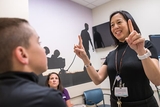
Building upon years of research, a new study from Children’s Hospital of Philadelphia (CHOP) has demonstrated how a specific assessment of the eye could someday help properly diagnose and monitor concussions. The findings were published today in JAMA Ophthalmology.
In the first study of its kind, the research team demonstrated that quantitative pupillary light reflex (PLR) metrics, which determine how the pupil responds to light and are obtained by using a hand-held dynamic infrared pupillometer (DIP), and can be used to differentiate concussed adolescent athletes from healthy adolescents.

“We know the visual system is affected after a sports-related concussion, and this is something that patients can’t intentionally control or hide. The pupil’s response to light is an autonomic function with metrics easily captured via automated dynamic infrared pupillometry,” said lead author Christina L. Master, MD, co-lead of the concussion research program and a pediatric primary care sports medicine specialist at CHOP. “We thought if PLR could distinguish between concussed and non-concussed adolescent athletes, we may have an opportunity for objective assessment where data is easily obtained via a hand-held device in clinical and sports settings.”
Seeking more effective ways to accurately diagnose concussion
Today, properly diagnosing a concussion is a challenge due to a lack of objective diagnostic tests for adolescents. In recent years, researchers at CHOP have studied the body’s visio-vestibular system — the sensory system that processes spatial motion and visual information — to seek objective biomarkers for concussion that can support diagnosis and guide individualized treatment and recovery plans.
Previous studies have shown concussion leads to difficulty adjusting visual focus and impairments in the autonomic nervous system, making the PLR a promising potential physiological biomarker for concussion. This prospective observational study sought to quantify these differences in PLR via DIP to provide clinicians with a future objective diagnostic tool.
The study, which took place at a specialty concussion program and private suburban high school, enrolled a cohort of adolescent athletes between 12 and 18 years old and included both healthy athletes (n = 134) and athletes with a diagnosis of sport-related concussion (SRC; n = 98). Researchers were interested in nine specific PLR metrics that objectively assess autonomic function, which occurs automatically, without a person’s conscious effort.
Study findings
The study found significant differences between concussed athletes and healthy adolescents for all PLR metrics except latency, or the time it takes for the pupil to respond to the light. Athletes with concussion had larger maximum and minimum pupil diameter, greater percentage constriction, and greater peak and average constriction and dilation velocity compared with healthy athletes. When the data were restricted to only concussions assessed within seven days of injury, seven out of the nine PLR metrics remained sensitive to identifying concussion as compared with healthy individuals.
The researchers also examined sex differences in the data. No sex differences were found in the healthy control group for any pupillary metric, confirming previously published research. However, there were differences observed for females with a concussion, who exhibited longer time to 75% pupillary re-dilation than males, which warrants further investigation to better characterize any sex differences in concussion.
Researchers hope these findings may lead to a future objective assessment tool for use in sports or urgent care settings, ultimately leading to more timely and accurate concussion diagnosis and treatment.
This study was published by CHOP’s Minds Matter Concussion Program as part of the Objective Translational Multi-domain Early Concussion Assessment Study, funded by National Institutes of Health (National Institute of Neurological Diseases and Stroke) and the Integrative Science to Advance Pediatric Concussion Diagnosis and Treatment Study, funded by the Pennsylvania Department of Health.
The Minds Matter Concussion Program has been designated a Frontier Program by CHOP. Frontier Programs are unique, cutting-edge programs that will forge important new discoveries, deliver novel therapies, and help even more children thrive. The CHOP researchers partnered with the Shipley School Athletics Program for this study.
Master et al, “The Utility of Pupillary Light Reflex Metrics as a Physiologic Biomarker for Adolescent Sport Related Concussion.” JAMA Ophthalmol, online September 24, 2020. DOI: 10.1001/jamaophthalmol.2020.3466.
Featured in this article
Specialties & Programs
Building upon years of research, a new study from Children’s Hospital of Philadelphia (CHOP) has demonstrated how a specific assessment of the eye could someday help properly diagnose and monitor concussions. The findings were published today in JAMA Ophthalmology.
In the first study of its kind, the research team demonstrated that quantitative pupillary light reflex (PLR) metrics, which determine how the pupil responds to light and are obtained by using a hand-held dynamic infrared pupillometer (DIP), and can be used to differentiate concussed adolescent athletes from healthy adolescents.

“We know the visual system is affected after a sports-related concussion, and this is something that patients can’t intentionally control or hide. The pupil’s response to light is an autonomic function with metrics easily captured via automated dynamic infrared pupillometry,” said lead author Christina L. Master, MD, co-lead of the concussion research program and a pediatric primary care sports medicine specialist at CHOP. “We thought if PLR could distinguish between concussed and non-concussed adolescent athletes, we may have an opportunity for objective assessment where data is easily obtained via a hand-held device in clinical and sports settings.”
Seeking more effective ways to accurately diagnose concussion
Today, properly diagnosing a concussion is a challenge due to a lack of objective diagnostic tests for adolescents. In recent years, researchers at CHOP have studied the body’s visio-vestibular system — the sensory system that processes spatial motion and visual information — to seek objective biomarkers for concussion that can support diagnosis and guide individualized treatment and recovery plans.
Previous studies have shown concussion leads to difficulty adjusting visual focus and impairments in the autonomic nervous system, making the PLR a promising potential physiological biomarker for concussion. This prospective observational study sought to quantify these differences in PLR via DIP to provide clinicians with a future objective diagnostic tool.
The study, which took place at a specialty concussion program and private suburban high school, enrolled a cohort of adolescent athletes between 12 and 18 years old and included both healthy athletes (n = 134) and athletes with a diagnosis of sport-related concussion (SRC; n = 98). Researchers were interested in nine specific PLR metrics that objectively assess autonomic function, which occurs automatically, without a person’s conscious effort.
Study findings
The study found significant differences between concussed athletes and healthy adolescents for all PLR metrics except latency, or the time it takes for the pupil to respond to the light. Athletes with concussion had larger maximum and minimum pupil diameter, greater percentage constriction, and greater peak and average constriction and dilation velocity compared with healthy athletes. When the data were restricted to only concussions assessed within seven days of injury, seven out of the nine PLR metrics remained sensitive to identifying concussion as compared with healthy individuals.
The researchers also examined sex differences in the data. No sex differences were found in the healthy control group for any pupillary metric, confirming previously published research. However, there were differences observed for females with a concussion, who exhibited longer time to 75% pupillary re-dilation than males, which warrants further investigation to better characterize any sex differences in concussion.
Researchers hope these findings may lead to a future objective assessment tool for use in sports or urgent care settings, ultimately leading to more timely and accurate concussion diagnosis and treatment.
This study was published by CHOP’s Minds Matter Concussion Program as part of the Objective Translational Multi-domain Early Concussion Assessment Study, funded by National Institutes of Health (National Institute of Neurological Diseases and Stroke) and the Integrative Science to Advance Pediatric Concussion Diagnosis and Treatment Study, funded by the Pennsylvania Department of Health.
The Minds Matter Concussion Program has been designated a Frontier Program by CHOP. Frontier Programs are unique, cutting-edge programs that will forge important new discoveries, deliver novel therapies, and help even more children thrive. The CHOP researchers partnered with the Shipley School Athletics Program for this study.
Master et al, “The Utility of Pupillary Light Reflex Metrics as a Physiologic Biomarker for Adolescent Sport Related Concussion.” JAMA Ophthalmol, online September 24, 2020. DOI: 10.1001/jamaophthalmol.2020.3466.
Contact us
Ben Leach
Minds Matter Concussion Program